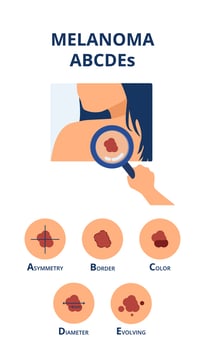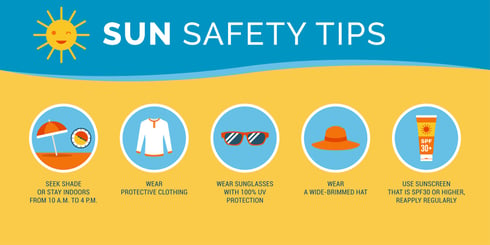Skin cancer is the most common type of cancer in the United States. Some cancers can be preventable. This article will share the risk factors for skin cancer and preventions you can take.
Skin cancer is the growth of abnormal cells in the outermost skin layer, caused by unrepaired DNA damage that triggers mutations. Skin cancer is when malignant (cancer) cells form in the skin's tissues. If the spread is not stopped, it may lead to more serious cancer and death.
Skin cancers are classified into three types:
- Basal cell cancer
- Squamous cell cancer
- Melanoma
Skin cancers of the basal and squamous cell types are common but less dangerous. Melanoma is more dangerous but less common than basal cell or squamous cell skin cancers.
The ABC's of Skin Cancer Detection
The ABCDs of Melanoma can help you identify potentially dangerous moles, but it's important to remember that these aren't the only traits of skin cancer. It's best to become familiar with the appearance of your moles so you can notice when they change. 
A-ASymmetry
A normal mole or birthmark is symmetrical, meaning that one half looks like a mirror image. Melanomas, on the other hand, are usually asymmetrical. The shape is irregular and may look odd or funny.
B-Border Irregularity
A melanoma will often have an irregular border that may be scalloped or notched. Borders of moles are typically smooth and even all around.
C-Color
Melanoma's color is usually uneven. Shades of black, brown, and tan are possible. White, gray, red, or blue areas may also appear. A benign mole is typically a single color that spans the entire area.
D-Diameter
The size of melanomas tends to be larger than a pencil eraser (about 6 millimeters). Benign moles are often smaller than this (less than 6 millimeters). It is still important to watch for changes in size and shape over time.
E-Evolution
Is your mole changing in any way? It's normal for moles to change slightly with age, but if you notice any sudden changes like bleeding or itching, this could indicate something more serious.

FAQ’s
Is Skin Cancer Preventable?
Skin cancer is the most common cancer diagnosis, and it's the most preventable cancer. Most skin cancer is caused by damage from the sun's ultraviolet radiation (UV rays). Though sunlight is the main source of UV rays, tanning beds and sunlamps can also emit them.
One of the best defenses to avoid skin cancer is to avoid excessive UV radiation exposure. How? The key is to protect your skin from harmful rays whenever you're in the sun.
Can It Be Cured if Caught Early?
If detected early that is when the melanoma is still thin, the cure rate for melanoma is nearly 100%. That's why it's critical to perform regular self-exams and consult a dermatologist if you notice changes to your skin.
Does Melanomas Look the Same for Everyone?
Melanomas can have a wide range of appearances. They usually consist of a brownish spot with darker speckles, but they can also be skin-colored, pink, red, purple, blue, or white.
Are Some People More at Risk for Melanoma Than Others?
You don't need to have a family history of melanoma to be at risk. The risk increases with age, but all adults should perform regular skin self-exams.
Skin cancer is the most common cancer diagnosis, and it's the most preventable cancer. Most skin cancer is caused by damage from the sun's ultraviolet radiation (UV rays).
Prevention Strategies 
- Wearing at least an SPF 20 sunblock daily or higher numbers of SPF are ideal
- Reapplying sunblock every 2 hours if in the sun, swimming, or exercising
- Seeking shade during the peak hours of 10 am to 4 pm
- Avoiding intentional tanning and tanning beds
- Using sunblock with the ingredients zinc oxide and/or titanium dioxide
- Have your skin examined at least once a year by a dermatologist
If you notice a change in your skin that may appear as a mole or skin tag that looks suspicious schedule an appointment with your dermatologist. Your doctor will be able to determine if it is cancerous or not and discuss treatment options with you if needed. Early detection will help you and your doctor plan the best treatment plan.
Read more of Life Springs’ articles on wellness and person-centered care.


